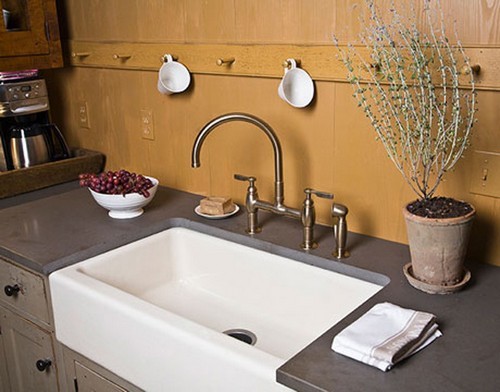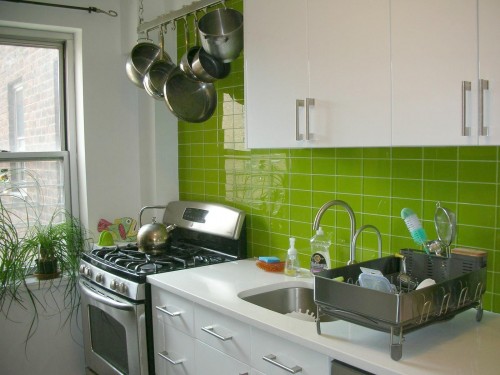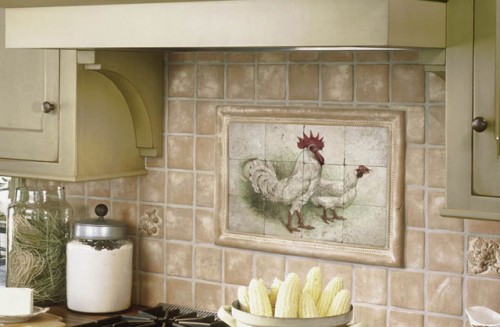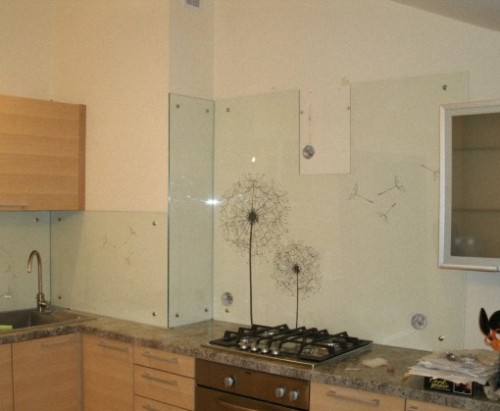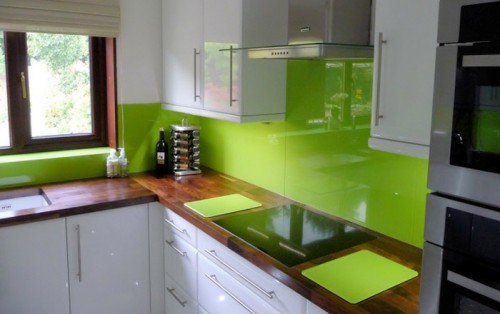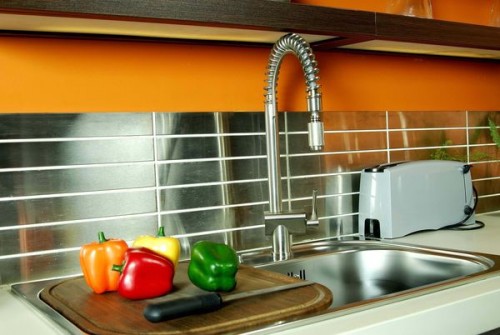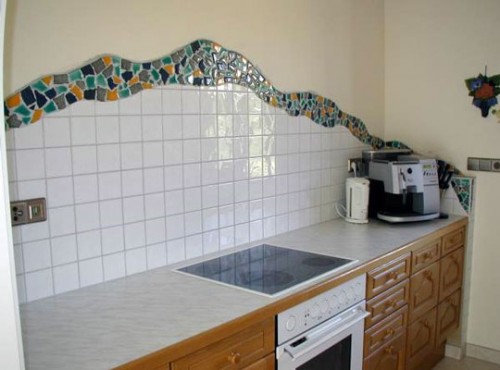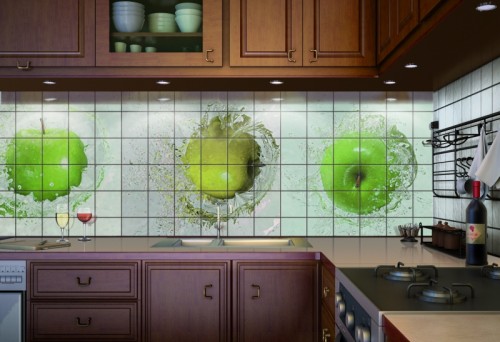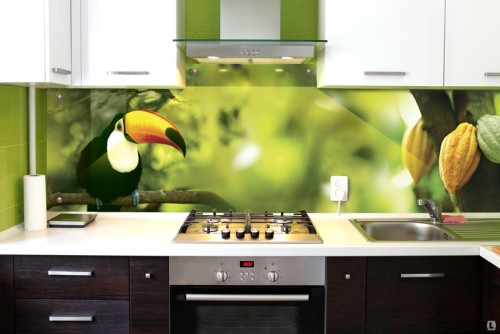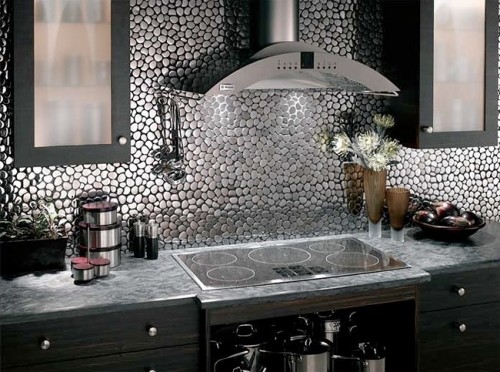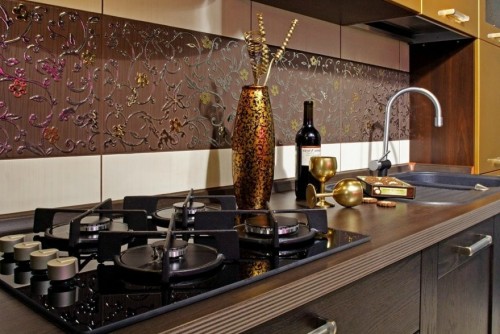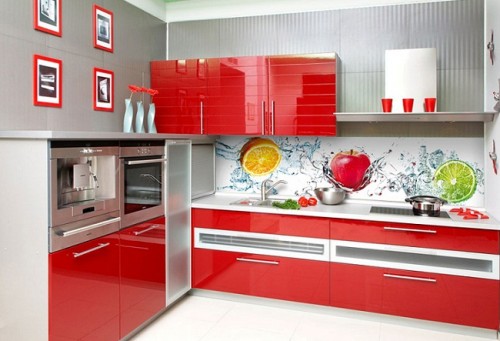The wall behind the sink and stove is the most susceptible to pollution in the kitchen, which is desirable to equip with dense and strong washing materials. For facing the kitchen, manufacturers produce material of various format. In most cases, you can make a functional and stylish apron for the kitchen wall on your own.
Content
Apron for the kitchen - materials
The apron for the kitchen is a specially trimmed wall panel in the working area - the choice of suitable materials for this is quite large. The specificity of the kitchen premises makes the following requirements for them: resistance to temperature differences, the effects of high humidity, kitchen pollution and detergents. For installation, you can use ceramic tiles, natural and acrylic stone, leaf steel, facing plastic, MDF, and even laminate and linoleum.
Ceramic tile for apron
One of the most popular options for finishing the apron for the kitchen is ceramic tiles. It is produced in different versions - smooth, embossed, matte, as well as glossy. For the kitchen, tiles with low porosity, covered with icing, 3-4 mm thick, are made. Tiles with “AA” labeling are resistant to chemicals and withstands multiple treatment with detergents. High resistance to temperature drops is marked on the packaging by Litera “T”. It is recommended to purchase wall tiles for a kitchen apron with a margin of 5-10% for subsequent minor repairs.
On sale are special panels for a apron with kitchen themes, there are many decoration options. Against the backdrop of furniture with decorative patterns and fittings, a ceramic apron for a kitchen from a fine -placed tile or plain tiles with infrequent inserts with drawings looks good. With a modern kitchen set with a smooth plain surface, texture tiles with a bright ornament look good.
One of the fashion trends is the use of clinker tiles for the finish of the kitchen apron - in the form of fresh or aged brickwork. Ceramic aprons with photo printing to the kitchen are also made - from individual elements you can post a photo, such images look very bright. Also, the already formed drawings of the mosaic for the kitchen on the apron are sold - based on adhesive paper, or you can choose the original ornament on your own.
Glass for the apron
Glass for a kitchen apron can be:
- color;
- matte;
- textured;
- mirror.
Glass panels are moisture resistance and durability, mechanical strength (except for shock) and resistance to aggressive chemicals. For cladding of the kitchen working area, it is recommended to use tempered glass with a thickness of 6 mm. In addition, the apron for the kitchen made of glass is not unlikely mounted, while the ideal leveling of the walls is not required - due to the fact that the glass can be fixed on the wall with the help of brackets. The wall panels of the kitchen apron can be decorated in every possible way using photo printing, patterns, place textiles, decorative plaster behind it. Various drawings are applied to a special film, which is glued to the inside of the panel.
The disadvantages of glass panels include:
- for cleaning glass panels, you can not use products with abrasive particles, as they scratch the glass;
- on the surface of the glass (especially glossy) there are spots and stains from water;
- such panels (if it is not tempered glass) poorly tolerate significant temperature changes, the distance from them to the heat source (kitchen plate) should be at least 5 cm;
- the image applied to the glass can eventually burn out under the influence of direct sunlight.
Other materials for the kitchen apron
Natural stone as a material for a kitchen apron looks very organic for kitchen interiors in country style. Such a relief wall surface is difficult to wash and clean, but in some cases, practicality can be sacrificed for decorativeness.
Aprons for the kitchen made of metal (sheet stainless steel) favorably differ in a flat and smooth surface.
The protective kitchen panel from MDF is resistant to kitchen steam and high humidity, as well as mechanical damage. Of the disadvantages, it should be noted that the material is the grief, so it is not recommended to install it in kitchens with gas stoves. MDF kitchen apron goes well with kitchen furniture from the same material. The sawing of this material is recommended to be carried out in the workshop to eliminate the appearance of chips and cracks.
Also, plastic is also used to equip the working area in the kitchen at home and cottages. This material is easy to install, under the kitchen of plastic, the walls are not required. In addition, the plastic is quite practical - it tolerates the effects of moisture and steam well, it is easily washed, subject to operating conditions is not deformed, fungi and mold are not formed on it. The disadvantages of this material in the kitchen include the fact that plastic does not tolerate the thermal exposure (when heated can be melted), and it also cannot be washed with aggressive detergents.
DIY kitchen apron
The following sizes are made kitchen aprons:
- the height from floor to apron is 85-90 cm, depending on the level of the countertop. It is necessary that the lower part of the kitchen apron is 10-15 cm below the level of the kitchen countertop;
- typically, the height of the kitchen apron is about 60 cm. Under the hood, the height of the kitchen apron can reach 80 - 90 cm. When calculating the height of the apron, it is necessary to consider how much it will go beyond the countertop, as well as its visible part and placement under the hinged cabinets;
- the width of the apron is usually equal to the length of the desktop, taking into account the kitchen sink and hood.
It is quite possible to cope with the installation of a kitchen apron in the kitchen yourself. It is necessary to choose the material according to the style of the kitchen interior, thoroughly plan the location of the apron, draw a layout plan for the material and mark the holes for the sockets on it, calculate the surface area and the required amount of the material.
Before installing the apron for the kitchen with your own hands, it is necessary to align and primed the wall surface. The cladding of the working area is performed after the end of finishing work in the kitchen and preliminary placement of kitchen cabinets.
Facing tiles
For facing the kitchen apron with ceramic tiles, the following materials and tools may be needed:
- spatulas - rubber and ordinary;
- tozda trowel (Kelma);
- construction level;
- primer fluid;
- moisture -resistant grout for sutures with antifungal additives;
- crossings for tiles;
- glue for tiles;
- metal profile or flat wooden bar;
- sponges;
- bulgarian and tiles;
- drill.
The following sequence of actions for laying an apron made of ceramic tiles is recommended:
- We mark the location of the tiles on the wall. You can do it in two ways:
- by applying the tile at the bottom of the mounted cabinet, we draw the line on the wall according to its lower edge. We apply the tile from the bottom of this line and mark the next row of tiles - and so we mark the entire future apron from top to bottom. To level you need to use the level;
- film the layout of the tile apron - lay out the tile on the floor with crossings for the seams and make dimensions, and then move the marking to the right place on the wall.
- We align horizontally and fix the metal profile for drywall or a wooden bar along the lower marking line - to support the tiles.
- We apply an uniform layer of glue to the tile, draw along it with a slight pressing with a gear cell - to obtain uniform bands of the solution. For the formation of seams, plastic crosses are used. We begin to lay the tiles from the more viewed angle and linen the main wall row behind the row, after which, if necessary, go to the corner part.
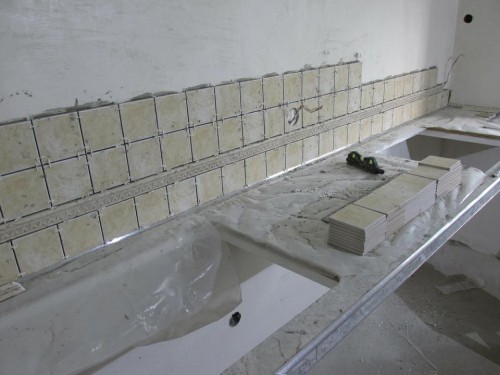
- Cut tiles are recommended to be located in the corner. You can cut the tile with a special machine (tile cutter) or a grinder.
- We mark the places under the outlet on the tile (the marking is applied from the back). If the outlet hole falls on two adjacent tiles, then we redraw it most of it, and then we finish the smaller one on the second tile by applying to the socket.
- The holes for the sockets are cut on the tile with a grinder with a diamond disk - or drilled with an electric drill using a drill along a tile or a special round nozzle with a diamond coating.
- In the upper row of laying the apron, the solution must be applied to the tile, not reaching the edge from above by 1-2 cm, so as not to stain the wall.
- At the end of laying at least 12 hours, we remove the crosses and a retaining bar. The seams are processed using a rubber spatula with a special grout. At the end of the cladding, it is recommended to additionally treat the seams with a sanitary silicone sealant.

